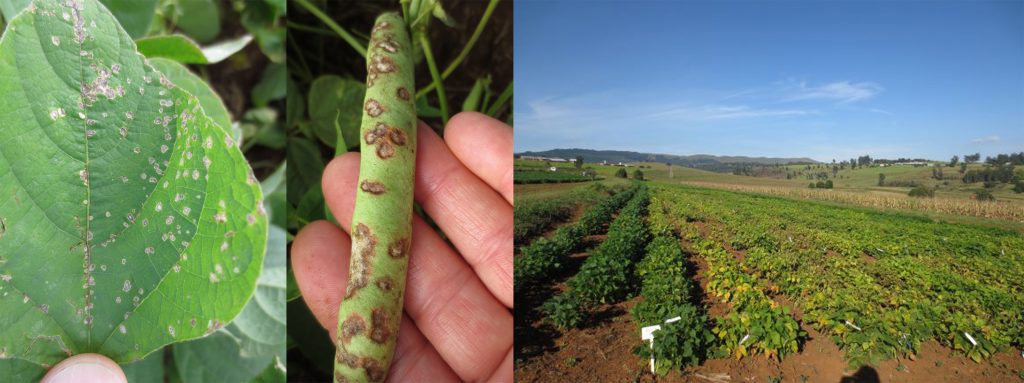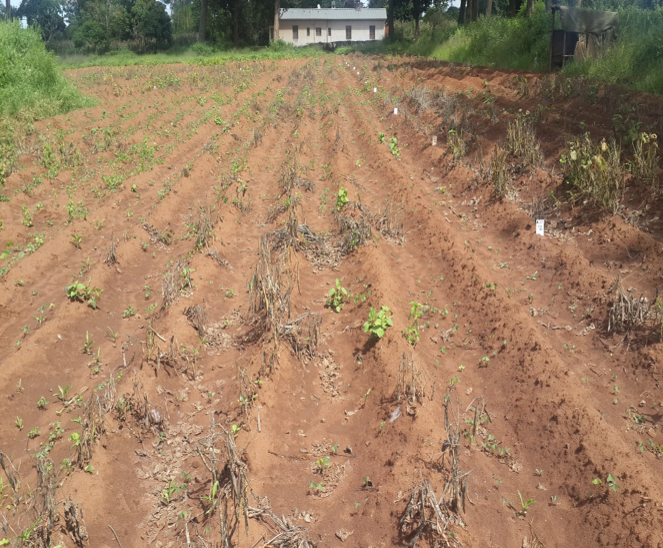- CENTA Chaparrastique, nueva variedad de frijol rojo, 2011
- CENTA Costeño, nueva variedad de frijol rojo para altas temperaturas, 2014
- CENTA CPC, nueva variedad de frijol rojo claro brillante, 2008
- CENTA EAC, nueva variedad de frijol rojo claro, 2015
- CENTA Ferromas, nueva variedad de frijol con mejor valor nutricional
- CENTA Nahuat, nueva variedad de frijol rojo claro, 2008
- CENTA Tacuba, nueva variedad de frijol negro brillante, 2018
- Costa Rica Nambi, nueva variedad resistente a sequía, 2017
- Costa Rica, Variedades de frijol grano rojo PITTA-Frijol, 2007
- Cuba, Cadena de valor de frijol, 2016
- Cuba, Lista de variedades comerciales, 2017-2018
- El Salvador, Brochure variedades de Frijol FP, 2012
- Guatemala, Recomendaciones técnicas para el cultivo de frijol en Peten, 2015
- Honduras, Variedades de frijol liberadas, 2018
- ICTA Chorti ACM Variedad de frijol arbustivo biofortificado con hierro y zinc, 2017
- ICTA Labor Ovalle, nueva variedad de frijon de enredo tipo bolonillo
- ICTA Peten ACM e ICTA Sayaxche, Nuevas variedades de frijol para el Peten, 2010
- ICTA Superchiva, nueva variedad de frijol, 2011
- ICTA Utatlan, nueva variedad de frijol de vara o enredo, 2017
- IDIAF Charlona Negra, nueva variedad de habichuela negra, 2017
- IDIAF DPC-40, nueva variedad de habichuela negra
- IDIAF Yaconin, nueva variedad de habichuela crema moteado, 2017
- Nicaragua, Variedades tolerantes a sequía, Noel Duarte
- P. Rico, B-128, B-190, B-351, 2B-5-1 Release of black beans 1979
- Rep. Dom., Socializacion de resultados de investigación
- Variedades de frijol liberadas-AgroMeso, 2004
Author Archives: ftfadmin
Preparation for release of cultivars in Tanzania
From 6/12 to 6/16/2019, advanced trials of lines from three generations of PIC (Phaseolus improvement cooperative) populations under consideration for release were evaluated at the Selian Station of the Tanzanian Agriculture Research Institute (TARI) and in on-farm trials in Arusha, and at the Uyole Station of TARI in Mbeya in collaboration with Drs. Susan Nchimbi and Luseko Chilagane of Sokoine University of Agriculture.
Due to initial and extended drought, the stands in the trial at Selian (Arusha) were affected and the planting was delayed, but plant stand and vigor data were collected. There was little disease pressure at the site. Superior Phaseolus Improvement Cooperative (PIC) lines (32 total) were evaluated in a combined trial and superior lines from two generations of selection included R11-7, 15 TZ MBY PIC 035-Row2, 15 TZ MBY PIC 038-Row4, and 15 TZ MBY PIC 040-Row1. ADP-447 (Yunguilla) and ADP-190 (Baetao Manteiga) showed superior vigor and yield potential in increases next to the trials. Mr. Alex Kisamo commented that he is impressed with ADP-447 for production in Tanzania. A subset of the DDP (with 8 entries) and a new pinto bean trial (with 59 entries) showed promise in comparison to the local pinto check.

Arusha Selian Station photos from left to right: Drs. Nchimbi, Chilagane, and Alex Kisamo (left); increases of ADP-447 (middle); and ADP-190 (right).
On 6/13 we travelled to three villages in the Kilimanjaro area near Arusha, Sakila, Kwanangasha, and Nasholi, with two extension agents. Soils at all three sites appeared to be composed of dark volcanic soils. Visual ratings based on vigor and stand were completed on a superior set of 18 PIC lines from those indicated above and on the 8 DDP pinto lines at the three villages in two replications. The Sakila site was likely 250m higher than the other two sites and it was noted that this trial had received additional rainfall and weed pressure. The farmer at this site plants yellow beans. The Kwanangasha site had higher weed pressure in the 2nd replication. The farmer had dedicated part of her field to green gram for home consumption. The final trial, Nasholi, was far superior than the others in terms of plant stand and vigor, and it appears the trial had better weed control and had been fertilized. There will be farmer evaluation data collected near harvest maturity and yield data obtained as well in these three trials.

Photos from left to right of on-farm trials in villages in Arusha area: Dr. Nchimbi, two extension agents, and farmer at his farm in Sakila village (left); trials at Kwanangasha village (middle); and trials at the Nasholi village (right).
On 6/14 we travelled to the Mbeya site in the Southern highlands of Tanzania and on 6/15 Dr. Nchimbi and I met Michael Kilango at the Uyole Station in Mbeya for data collection. We were impressed with the good stands, vigorous plant growth, and advanced stage of the trials. These trials were planted 2-3 weeks earlier than the Arusha trials. The trials were also fertilized with urea at the flowering stage—unlike most of the other trials (except for the Nasholi trial). We collected ALS, rust (for some trials), overall agronomic performance, and in some cases plant stand data. Michael Kilango noted that farmers passing by the fields were interested by the ADP-447 increase and that some had requested seed of this line. PIC lines performing well in Arusha also performed well in Mbeya for the most part. Pinto performance was superior in Mbeya with some lines showing good adaptation, yield potential and disease resistance. A subset (20 RILs) from the CAL 143/Rojo RIL population (3 reps) and 158 RILS from the Bukoba/Kijivu RIL population (1 rep) were evaluated for ALS. The Iwanga village on-farm trial, in the Mbeya area, will be visited by collaborators for agronomic and farmer participatory evaluations.

Mbeya Uyole trials (left photo); rust (pictured) and angular leaf spot (ALS) symptoms present (middle), superior pinto with early maturity and adaptation (right).
The visit was effective in the selection of PIC lines for potential release in Tanzania and in the U.S. We plan to initiate the process for the release of ADP-447 and ADP-190 in Tanzania. The PIC performance between Mbeya and Arusha was remarkably consistent, with ADP-447, ADP-190, R11-7, 15 TZ MBY PIC 035-Row2, 15 TZ MBY PIC 038-Row4, and 15 TZ MBY PIC 040-Row1 continuing to perform well and being considered for release.
Evaluation of Phaseolus Improvement Cooperative (PIC) selections in South Africa
Two generations of PIC population selections and advanced lines under consideration for release were evaluated at the ARC Station in Cedara for disease resistance, under high temperature at the ARC Station in Vaalharts, and at Potchefstroom from 3/27-4/2/19.
In the trials at Cedara, the principal disease was scab with both pod and leaf symptoms identified (photo below), but halo blight, rust, and angular leaf spot (ALS) were also found. An advanced first-generation of PIC population selections, with 80 entries in 3 replications from populations 1 to 153, were evaluated for potential release. A second set of PIC selections, from a second generation of PIC populations 154 to 275 and composed of 677 lines, were also evaluated in 3 replications. All plots were evaluated for pod load (1-9 scale), maturity (1-3 scale), and disease response (1-9 scale) and preliminary selections were completed.
At the Jan Kempdorp ARC Station in Vaalharts response to high temperature stress was evaluated. The bean trial at the Vaalharts field site was located at 27⁰56.759 S, 24⁰50.548 E and at 1162 masl and has average temperatures of 35-38⁰C (day) and 16-18⁰C night during the season. Visual ratings based on pod load were completed on the same set of 80 PIC lines as indicated above in three replications and on 285 lines (previously selected in Vaalharts) from the second generation mentioned above. In addition to pod load, disease response, maturity, and virus-like symptom data was also collected.

Vaalharts photos from left to right: Drs. Miklas, Fourie, and Porch at Vaalharts trials, virus symptoms, heat-adapted versus sensitive lines.
At the Potchefstroom trials of Deidre Fourie selections from the PIC breeding lines with a sugar or calima seed type were evaluated for potential release in South Africa. A number of these lines had promising yield potential in Potchefstroom. RILs from the Rojo x CAL 143 population combining multiple disease resistance were also evaluated for yield potential, seed type, and for potential release.
A subset of these PIC lines with commercial seed type will be evaluated in yield trials in South Africa, and sent to U.S. collaborators for phenotypic and genotypic evaluation and for potential release or use in breeding programs in the U.S.
Historical Common Bean Research Publications from Puerto Rico
- Release of Violeta – 1976
- Release of Palmarejo – 1976
- Release of Oro Rico – 1976
- Release of multiple disease resistant scarlet runner bean germplasm – 1979
- Release of MITA-76-R287 – multiple disease resistant black bean – 1979
- Release of MITA RSP-1, RSP-2, RSP-3 and RSP-4 – 1979
- Release of Congo Rico – 1976
- Release of Chorro – 1979
- Release of Carbon – 1979
- Release of black beans B-128, B-190, B-351, 2B-5-1 – 1979
- Release of black bean La Vega -1973
- Release of 4M-99 – multiple disease resistance – 1983
- Release of kidney beans 3M-150 and 3M-152 – 1983
- Release of Mogote – 1979
- Release of XR235-1-1 – common blight resistant interspecific line – 1981
- Release of white beans W-117, W-142 and 2W-33-2 – 1979
- Release of white bean MITA 6383 – 1979
- Release of white bean lines L226-10 and L227-1 – 1983
Dr. James Beaver and Dr. Juan Carlos Rosas awarded the BIFAD Scientific Excellence in a Feed the Future Innovation Lab Award
The prestigious Board for International Food and Agricultural Development (BIFAD) Scientific Excellence in a Feed the Future Innovation Lab Award was granted to Dr. James Beaver of the University of Puerto Rico and Dr. Juan Carlos Rosas of the Zamorano Panamerican Agricultural University in Honduras. Their outstanding, long-term collaboration, encompassing 30 years of research, has resulted in synergistic advances in pyramiding disease, abiotic and insect resistance in cultivars spanning Central America and the Caribbean, and has resulted in substantial gains in education, training and institutional development.
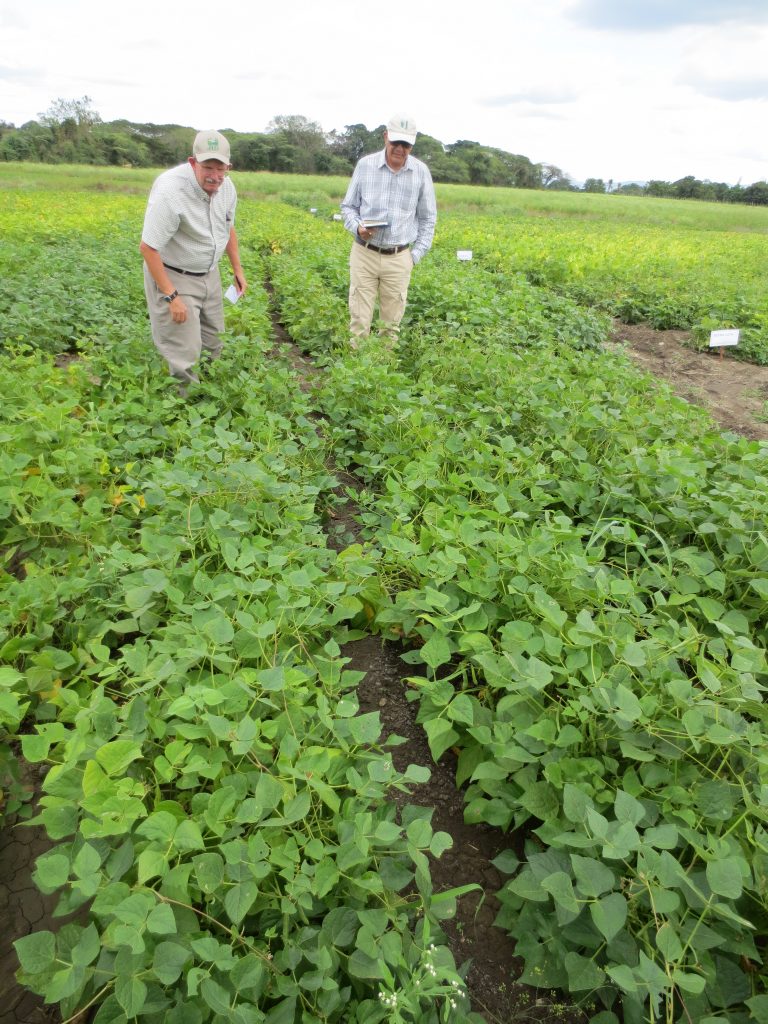
Dr. Rosas and Dr. Beaver evaluating breeding lines at the Arroyo Loro Station in the Dominican Republic, February 2017
Bean golden yellow mosaic virus (BGYMV), a critical constraint to common bean production in the Caribbean and Central America, has been a central component of their breeding objectives. They played crucial roles to the early characterization and development of BGYMV resistant cultivars using germplasm developed at CIAT-Guatemala and the U. of Wisconsin in the 1980s and 1990s. This early progress has allowed for the current broad implementation of BYGMV resistance in common bean cultivars developed for the Caribbean and the Central American region. They have implemented an elevated standard for release of multiple virus resistant cultivars, through the pyramiding of BGYMV, BCMV, and BCMNV resistance, and the incorporation of accelerated breeding methods such as marker assisted selection. These recent efforts have resulted in releases of high yielding cultivars that combine general abiotic and biotic resistance in addition to this multiple virus resistance and include: ‘Sankara’, ‘Bella’, ‘MEN 2201-64 ML’, ‘Aifi-Wuriti’, ‘Beniquez’, ‘PR0737-1’ and ‘PR0806-80’. During the last period of this collaborative effort they have released over 23 cultivars and germplasms that will impact thousands of subsistence and commercial farmers throughout the region and many more consumers.
Instead of focusing solely on the genetic diversity available within common bean, Dr. Beaver and Dr. Rosas pursued the use of other Phaseolus species as sources for bruchid (or grain weevil) and heat/drought tolerance, specifically from tepary bean (P. acutifolius). This seminal work on bruchid (Acanthoscelides obtectus Say) resistance is a game changing post-harvest achievement as it alleviates rapid degradation of seed and grain quality in the tropics and subtropics, particularly affecting poor farmers. The germplasm developed from these efforts represent the first broad implementation of bruchid resistance in the development of cultivars of Andean and Mesoamerican seed classes. The recent release of the red mottled ‘AO-1012-29-3-3A’, that combines BCMV and BCMNV resistance with bruchid resistance, is a milestone in this effort.
Their early recognition of the potential detrimental effects of climate change on common bean production worldwide resulted in early breeding efforts focused on improving both drought and heat tolerance and in improving yield stability in current common bean production systems in Central America and the Caribbean. Through the establishment of new low-land tropical selection environments in locations like Nacaome, Honduras, summer season testing in Isabela and Juana Diaz, Puerto Rico, and in collaborative testing sites in other countries such as El Salvador and Guatemala, they have achieved significant advances in heat and drought tolerance. The recently collaborative release of ‘CENTA EAC’ in El Salvador, with higher yield potential under high temperatures and drought, follows the earlier release of the heat tolerant cultivar ‘Amadeus 77’, the most broadly grown common bean cultivar in Central America. In addition, the recent release of ‘Don Rey’ in Honduras and of ‘MEN2201-64ML’ in Haiti promise to improve common bean yields under increasing temperatures and drought, while also combining critical disease resistance traits. Additional traits, such as biological nitrogen fixation, low-fertility tolerance, and resistance to web blight are additional focal areas of their research collaborations where significant advances have been made.
In addition to the development of scientific innovations that have had broad impact in the common bean sector, Drs. Rosas and Beaver have provided innovative leadership for scaling-up and disseminating these innovations through technology transfer. One key application has been the development and promotion of local seed multiplication systems in Haiti and Central America to ensure that smallholder farmers have access to quality seed of varieties with improved genetics. Dr. Rosas is specifically recognized for his leadership in and advocacy of participatory plant breeding approaches. As a result, these methods are utilized worldwide by grain legume breeders because of the value of farmer input in trait selection and of improved adoption of farmer-researcher collaborative cultivar selections. The widespread demand in Honduras for the newly released cultivar ‘Parasito Mejorado 2- Don Rey’, a small-red seda seed type with excellent adaptation to the agro-ecologies of the region, is an example of the effectiveness of the participatory breeding approach.
As a community we congratulate Dr. Beaver and Dr. Rosas for their outstanding research advances, their extensive training and education contributions, and their example as to what can be achieved as a collaborative team. Their contributions as a collaborative team to the common bean research community, and more importantly to farmers worldwide, are greatly appreciated.
Central American/Caribbean Regional Bean Research Workshop (July 25-27, 2017)
The SO1.A4 Project of the Legume Innovation Lab held a workshop in Tegucigalpa, Honduras from July 25-27, 2017. The program and relevant presentations representing Central American/Caribbean regional bean research efforts are posted. All workshop presentations available for download are in Spanish. The summary of the workshop in available in English here.
Workshop schedule in PDF Format (download)
Tuesday, July 25, 2017
Report of research achievements for the past five years
(Click on bulleted text to download PDF)
- Panama (Emigdio Rodríguez)
- Costa Rica (Juan Carlos Hernández)
- Nicaragua (Aurelio Llano) (not available)
- Honduras (Danilo Escoto)
- El Salvador (Aldemaro Clará)
- Guatemala (Angela Miranda)
- Mexico – IDIAF (Francisco Ibarra)
- Haiti (Raphael Colbert)
- Dominican Republic (Bernardo Mateo)
- Zamorano (Juan Carlos Rosas)
- Puerto Rico (UPR and USDA-ARS) (James Beaver and Consuelo Estevez)
Wednesday, July 26, 2017
Research priorities for the next ten years
(Click on bulleted text to download PDF)
- Panama (Emigdio Rodríguez)
- Costa Rica (Juan Carlos Hernández)
- Nicaragua (Aurelio Llano) (not available)
- Honduras (Danilo Escoto)
- El Salvador (Aldemaro Clará)
- Guatemala (Angela Miranda)
- Mexico – IDIAF (Francisco Ibarra)
- Haiti (Raphael Colbert)
- Dominican Republic (Bernardo Mateo)
- Zamorano (Juan Carlos Rosas)
- Puerto Rico (UPR and USDA-ARS) (James Beaver and Consuelo Estevez)
Wednesday, July 27, 2017
Featured Articles – Feed The Future Bean Research
Featured Articles – Feed The Future Bean Research
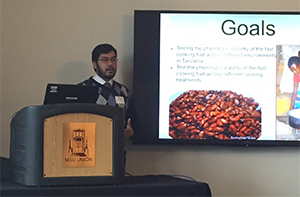
Diego Crespo an undergraduate assistant studying cooking time in dry beans in Karen Cichy’s lab wins the grand prize for his research presentation at the Michigan State University Undergraduate Research and Arts Forum in April 2016.
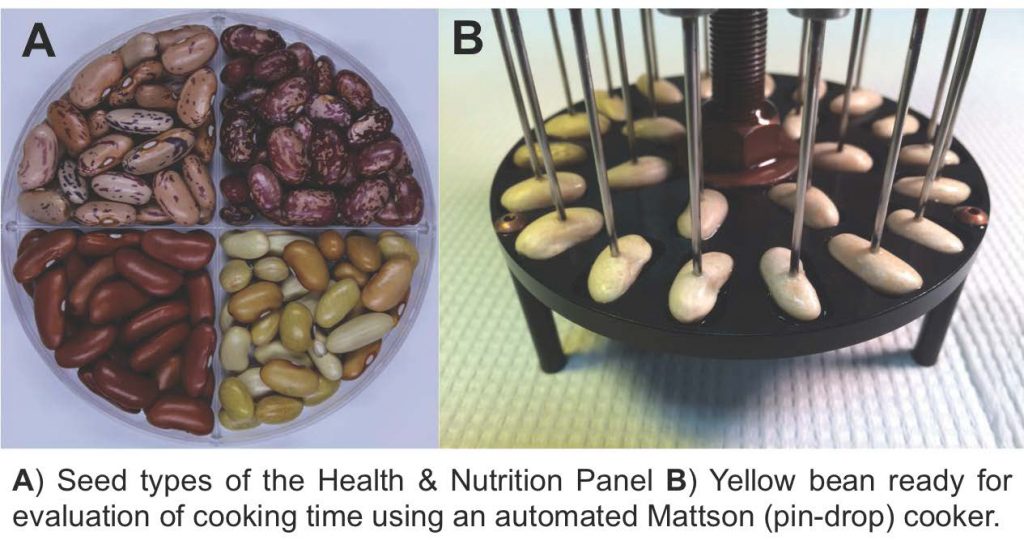
“Fast-cooking dry beans provide more protein, iron than ‘slower’ varieties” news story highlights the research study “Demonstrating a Nutritional Advantage to the Fast-Cooking Dry Bean (Phaseolus vulgaris L.)” by Jason Wiesinger, Karen Cichy et al. published in the Journal of Agricultural and Food Chemistry in November 2016.
Shipment of 12 tons of virus resistant black bean ‘Sankara’ to Haiti
In collaboration with the University of Puerto Rico, Basin Seeds Inc. (Idaho), and USAID, the USDA-ARS Feed-the-Future Grain Legumes Project shipped over 12 tons of ‘Sankara’ black bean seed to Haiti that arrived on Nov. 16, 2016. This seed, urgently needed due to hardships caused by Hurricane Matthew, was produced with the goal of testing a model for providing a secure, annual supply of high quality, disease-free, Western U.S. grown common bean seed to countries such as Haiti that have a perennial shortage of seed and are vulnerable to extreme weather events including droughts, tropical storms and hurricanes.
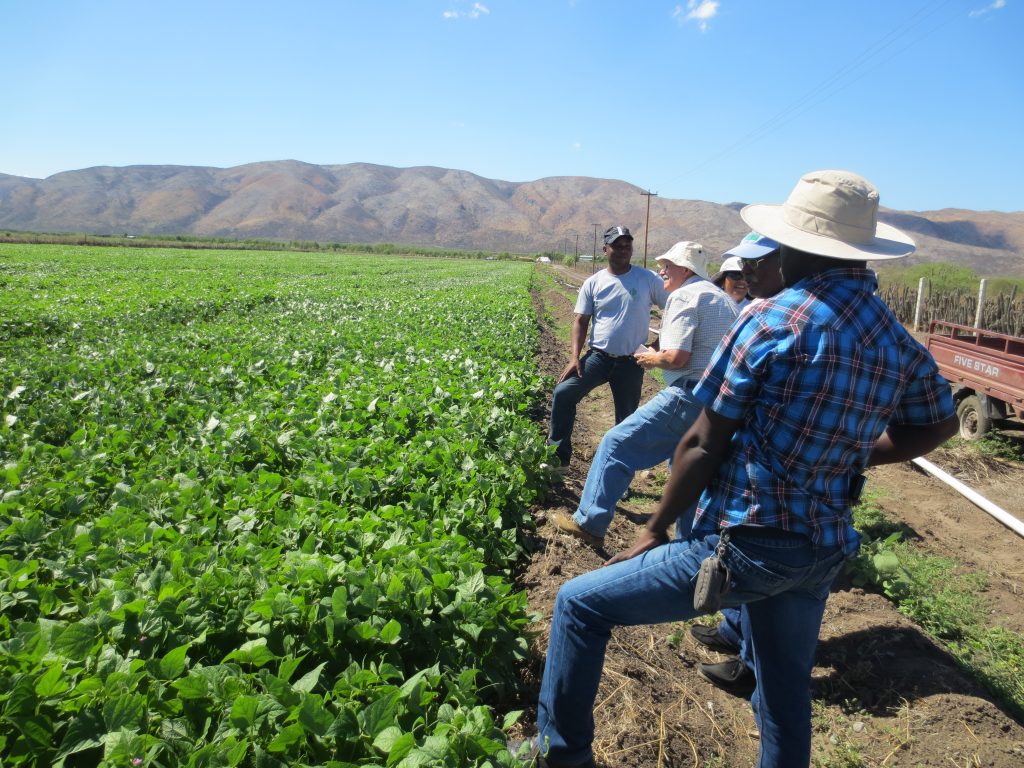
Seed increase of Sankara in February 2014 at the Hands Together NGO in Gonaives, Haiti. In the photo are Jim Beaver and Consuelo Estevez of the U. of Puerto Rico, Emmanuel Prophete from the National Seed Service of Haiti, and several technicians from the NGO.
‘Sankara’, tested as XRAV-40-4 and released in Haiti in 2015 has good yield potential and resistance to BGYMV (Bean Golden yellow Mosaic Virus), BCMNV (Bean Common Mosaic Necrosis Virus) and BCMV (Bean Common Mosaic Virus), key viral diseases in Haiti. ‘Sankara’ has exhibited early maturity and superior yield in the highlands of Haiti during the summer. Dr. James Beaver sent 30 lbs. of Breeder Seed to Dr. Phil Miklas and 1,000 lbs. of Foundation Seed was obtained in a field planting in Othello, Washington during the summer of 2015. The line was well adapted, early maturing, and produced high-quality seed in Washington at a multiplication rate of 30. This Foundation Seed was inspected and certified by Washington State Department of Agriculture and later accepted by Idaho State Department of Agriculture for increase in Idaho by the Basin Seed Company.
Dr. Ron Riley and Mike McKenna, co-owners of Basin Seed Company in Nampa, Idaho, planted the Foundation Seed of ‘Sankara’ and produced 27,000 lbs of Certified Seed in September, 2016. The seed is disease-free, high quality and genetically pure with 92% germination and 99.98% purity. Through expedited cleaning, processing, and packaging in 50 lb bags with a Haitian Creole label, Basin Seeds was able to ship 500, 50 lb bags to Haiti on 7 October, arriving in Haiti on 16 November and in time for the November/December 2016 Winter planting season. This is sufficient seed for almost 500 acres during the irrigated winter season in Haiti. A modest yield of 1,200 lbs/acre would produce a sufficient amount of seed of ‘Sankara’ to be planted on small-scale farms in the mountains during the summer of 2017 on over 9,000 acres.
Advancing Dry Bean Germplasm and Cultivar Development for Resource Poor Farmers in Malawi
The rainfall distribution for the 2015-16 Malawi crop growing season was in general below normal in many parts of the country. Drought conditions prevailed in many areas and crop yields were adversely affected including maize, the staple food for the country. The figure below shows rainfall distribution at the Salima site.
A subset of 10 Andean Diversity Panel (ADP) and 13 Durango Diversity Panel (DDP) lines that had been selected for good performance under biotic and abiotic stresses across Malawi, Tanzania, South Africa, Puerto Rico and the United States were planted at Bunda, Bvumbwe, MUST, and Chitala. The materials were grown in 4 row plots with three replications at each location. Phenological, yield and yield component data were determined.
The PIC population selections were planted at the same four sites (Bunda, Bvumbwe, MUST and Chitala). There were 282 lines planted as single row plots that were replicated three times. Plants were selected based on agronomic performance and tolerance to biotic and abiotic stresses in the field at the pod-filling stage, followed by seed type at harvest.
The National Bean Yield Trials (NBYT) comprised materials from the Bean/Cowpea CRSP project conducted from 2004 to 2007. The seed types range from small- to large-seeded and from solid to mottled seed colors. The lines are a mix of Andean and Mesoamerican lines and a variety of seed types including black, small red, carioca, brown, sugar cranberry, large red and red mottled.
Performance of bean trials
Drought had a profound effect on the trial performance resulting in loss of some trials at Bunda and MUST. The trials at Chitala were also drastically affected by drought and root rot. Bean common mosaic virus was prominent at Bunda and black-root reaction was observed in ABYT and ADP/DDP trials which contributed to poor stand apart from the drought that was experienced. PIC lines and the NBYT performed better in the second planting. Charcoal rot, caused by Macrophomina phaseolina, was the major disease at Bvumbwe in addition to drought stress, and the worst affected was the ADP/DDP trial (photo below).
PIC selections were made mainly at Bunda and Bvumbwe but a few were also included from Chitala. Selections at Bunda and Bvumbwe were based on pod load and seed type. In Chitala, all plants that survived the drought and produced seed were picked. Out of 282 lines derived from single plant selections done in 2014/2015 cropping season, 82 lines (29%) were selected and sent to South Africa for seed multiplication and advance.
The results of NBYT at Bunda showed highly significant differences in yield. Lines PC543-C3 and DG 2 were the earliest to achieve full flowering while the lines F11 MDRB (B) 25 and F11 MDRB (B) 24 were the first to reach physiological maturity. The highest yield was observed for the Kalima variety (2,858 kg/ha) followed by UCD 0234 (2,444 kg/ha). The overall mean yield was 1,771 kg/ha.
The NBYT results from the Bvumbwe Research Station showed highly significant statistical differences between the entries for days to flowering, days to maturity and 100 seed weight. There was no statistical significance in terms of grain yield among entries indicating similar yield performance. The earliest line to achieve physiological maturity was F12MDRB (A) 18 after 79 days. The top yielding line was F11MDRB (B) 24 (photo below) with 1,509 kg/ha followed by F3 MDRB (A) 8 with 1,378 kg/ha and UCD0234 with 1,365 kg/ha. The overall mean yield was 956 kg/ha.
The 2015/2016 crop growing season was challenging for crop growth and production. This was mainly due to drought. Trials from two of the sites, MUST and Chitala Research Station, were drastically affected and no data was collected. Two of the trials at Bunda, ADP/DDP and ABYT, recorded poor stands and this affected yield performance. Two trials, NBYT and PIC, had to be replanted at Bunda. Therefore, it is recommended that the ADP/DDP and NBYT be repeated in the 2016/2017 growing season. The PIC line selections sent to South Africa should be evaluated at multiple sites in order to determine their adaptation and to select outstanding entries for preliminary yield trials. Three lines from the NBYT, F11 MDRB (B) 24, DC 96-69 and DG 226, are being considered for release.

